Bed bugs are known for their ability to quickly infest homes, making them one of the most challenging pests to control. Understanding how fast bed bugs multiply and how they reproduce is crucial for preventing and managing infestations.

 Myths and Facts About Bed Bug Multiplication
Myths and Facts About Bed Bug Multiplication
How Do Bed Bugs Reproduce?
Bed bugs reproduce through a unique process called traumatic insemination. Unlike many other insects, bed bugs do not have a typical mating ritual. Instead, the male bed bug pierces the female’s abdomen with its reproductive organ and directly deposits sperm into her body cavity. This process bypasses the female’s reproductive tract entirely, allowing the sperm to fertilize the eggs within the female’s body. Once fertilized, the female bed bug begins to lay eggs. A single female can lay between 200 and 250 eggs over her lifetime. These eggs are tiny, about the size of a grain of salt, and are often laid in hidden areas such as cracks in walls, mattress seams, and furniture joints. The eggs are sticky, which helps them adhere to surfaces, making them difficult to spot and remove.
How Quickly Do Bed Bugs Multiply?
The speed at which bed bugs multiply is one of the reasons they can be so difficult to control. Under ideal conditions, bed bugs can reproduce rapidly, leading to a significant infestation in just a few months.- Egg Stage: Bed bug eggs typically hatch within 6 to 10 days. The time period depends on the surrounding temperature and humidity, with warmer conditions speeding up the hatching process.
- Nymph Stage: After hatching, the bed bug nymphs go through five molts before reaching adulthood. During each stage, they must feed on blood to grow. Nymphs are lighter in color and smaller as compared to adults, making them harder to detect.
- Adult Stage: Once they reach adulthood, bed bugs are ready to reproduce. An adult bed bug has a life span of several months and can reproduce continuously, laying eggs every day after a blood meal.
Do Bed Bugs Multiply When Killed?
A common myth is that bed bugs multiply when killed. This is not true. Bed bugs do not reproduce after death. However, if bed bugs are improperly killed, such as by squishing them, it’s possible to spread their eggs or blood, leading to contamination. Proper pest control methods are essential to ensure that bed bugs are properly eliminated and do not spread.Tips for Controlling Bed Bug Multiplication
Preventing bed bugs from multiplying is key to managing infestations. Here are some practical steps to consider:- Regular Inspections: Regularly inspect common bed bug hiding spots, such as mattresses, bed frames, and furniture crevices, to catch infestations early.
- Heat Treatment: Bed bugs cannot survive high temperatures. Hot water wash of bedding and clothing can kill bed bugs and destroy their eggs.
- Sealing Cracks: Sealing cracks and crevices in walls, floors, and furniture can reduce the number of shelters for bed bugs and make it harder for them to lay eggs.
- Professional Pest Control: It’s best to contact a pest control experts if you suspect a bed bug infestation. They can implement strategies that target all stages of the bed bug life cycle.
 Myths and Facts About Bed Bug Multiplication
Myths and Facts About Bed Bug Multiplication
| Myths | Facts |
| Bed bugs multiply when killed. | Bed bugs do not reproduce after death, but improper killing can spread contamination. |
| Bed bugs only lay eggs in dirty environments. | Bed bugs can lay eggs in any environment, regardless of cleanliness. |
| Bed bugs multiply slowly, making infestations manageable. | Bed bugs have the potential to double their population every 16 days under optimal conditions. |
| Squishing bed bugs stop them from multiplying. | Squishing bed bugs can spread their eggs and blood, leading to further contamination. |
| Bed bugs need large amounts of blood to reproduce. | Bed bugs can reproduce with minimal blood meals, making them highly efficient. |




